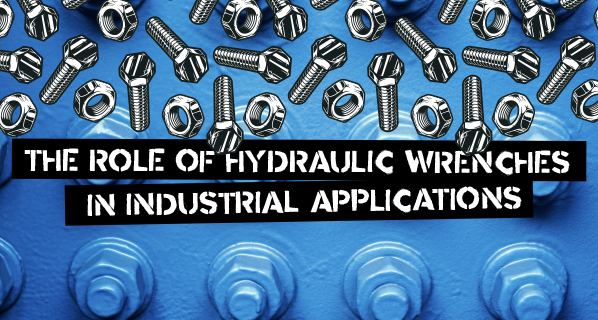The Role of Hydraulic Wrenches in Industrial Applications

By Charlie Carmichael, CEO, ALLTORC Industrial Bolting Solutions.
Hydraulic torque wrenches are devices used to supply a specific amount of torque to tighten or loosen nuts and bolts. This hydraulic set up consists of two main components: the hydraulic pump, which is typically either electrically or pneumatically driven, and a hydraulic wrench that actually delivers the torque directly onto the bolt. These wrenches typically come in two different styles, a square drive style and a low-clearance style. Hydraulic wrenches have become indispensable in various industries due to their accuracy and easy operation compared to other tools. They are used for tasks such as tightening large nuts and bolts, when installing machinery components, structure-steal joints, flanges in the water, oil and gas sectors along with applications in many other industries.
In this article, we’ll explore the role of a hydraulic torque wrench and its application across industries.
What are hydraulic wrenches used for?
The versatility of hydraulic torque wrenches makes them a worthwhile investment for any industry that requires precision when working with multiple sized fasteners and bolts. The ability to accurately apply the desired torque and cope with the most demanding applications makes hydraulic wrenches an indispensable tool across industries. The design of hydraulic wrenches also means they can provide a high torque output when compared to traditional hand tools, such as spanners, ratchets or standard torque wrenches.
Hydraulic torque wrenches are available in a range of sizes depending on the application requirements, from small handheld units suitable for light-duty jobs right up to large, high-powered wrenches for heavy-duty tasks. The torque setting and amount of force applied are easily adjustable via a control dial located either on the hydraulic pump, allowing operators greater precision when dealing with delicate components.
As well as offering precise accuracy and great durability options, hydraulic torque wrenches provide controlled tightening and also offer increased safety, as once employees have been efficiently trained on the job, even those who may not have much experience handling hydraulic equipment should be comfortable using the tool.
How do Hydraulic Wrenches work?
Hydraulic torque wrenches are used to tighten or loosen bolts and nuts with high precision and efficiency. They utilize hydraulic pressure to apply controlled torque to fasteners, offering several advantages over traditional manual wrenches or pneumatic tools. Let’s explore the technology and applications of hydraulic torque wrenches in more detail:
Hydraulic torque wrenches consist of a hydraulic power pack and a torque wrench. The power pack generates hydraulic pressure using an electric or pneumatic motor, which is then transmitted through hydraulic hoses to the torque wrench. The torque wrench typically features a reaction arm or reaction pad, a drive mechanism, and a socket or ratchet link to engage with the bolt or nut.
The key components of a hydraulic torque wrench include:
Hydraulic Power Pack: This unit includes the hydraulic pump, which generates the pressure up to 70 MPa (10,000 psi) required for torque application. It also contains a reservoir for hydraulic fluid, valves for controlling pressure and flow, and safety features such as pressure relief valves. It is at the hydraulic power pack where you make all your pressure adjustments to achieve the proper torque.
Hydraulic Hose: The flexible hose transmits the hydraulic pressure from the power pack to the torque wrench. It is designed to withstand high pressure and ensure efficient power transmission.
Torque Wrench: The torque wrench is available in various configurations, such as square drive or low-profile, to suit different applications. It incorporates a mechanism that converts hydraulic pressure into rotational force to tighten or loosen bolts.
Reaction Arm or Pad: To counteract the torque reaction and provide stability during operation, a reaction arm or pad is used. It rests against a sturdy surface to absorb the reactive forces generated when torque is applied.
What are the different types of hydraulic torque wrenches?
The different types of hydraulic torque wrenches include:
 1. Low profile hydraulic torque wrenches –
1. Low profile hydraulic torque wrenches –
Low profile wrenches provide the ideal solution for tight, hard-to-reach areas in various industries. These torque wrenches are ideal for tight spaces, where there is limited “above the nut / axial” clearance. They provide an accurate high torque output where other standard tools could not fit. This style tool is made to be able accommodate all different size fasteners from 20 mm – 195 mm (⅞” – 7-⅝”), and times even larger. This makes an ideal tool for any fastening jobs or applications where you are located in very compact spaces.
 2. Square drive hydraulic wrench – A versatile device used for tightening or loosening bolts and nuts. It features a square drive mechanism where a socket or interchangeable socket heads can be attached. This type of bolting tool allows for efficient and secure torque application, making it a popular choice in construction, manufacturing, and automotive. The square drive design enables easy interchangeability of sockets and an adjustable reaction arm which allows the tool to have multiple reaction points, facilitating adaptability to different fastener sizes and applications while achieving precise torque control.
2. Square drive hydraulic wrench – A versatile device used for tightening or loosening bolts and nuts. It features a square drive mechanism where a socket or interchangeable socket heads can be attached. This type of bolting tool allows for efficient and secure torque application, making it a popular choice in construction, manufacturing, and automotive. The square drive design enables easy interchangeability of sockets and an adjustable reaction arm which allows the tool to have multiple reaction points, facilitating adaptability to different fastener sizes and applications while achieving precise torque control.
What are the industrial applications of a hydraulic torque wrench?
The applications of a hydraulic torque wrench are numerous, as they provide a safe and efficient way to perform complex tasks with precision. From automotive manufacturing plants to petrochemical refineries, these devices can be used in many industries for fastening bolts or tightening nuts. The range of sizes available makes them suitable for light-duty use right through to heavy-duty bolting applications, making them an invaluable tool across a wide variety of industries.
Automotive and manufacturing
In automotive manufacturing plants and general manufacturing processes, hydraulic torque wrenches are used for precise bolt tightening on engines, chassis, and machinery. They help achieve consistent torque values, ensuring product quality and safety.
In automotive production lines, a hydraulic wrench can provide excellent levels of speed and accuracy when assembling components such as engines or gearboxes — ensuring that each component is correctly fitted with minimal effort from operators. This helps reduce assembly time while also mitigating any potential safety risks associated with incorrect torque being applied due to over-tightening or under-tightening bolts etc.
Construction and infrastructure
Hydraulic torque wrenches are used in the construction of buildings, bridges, and large structures that require heavy-duty bolting. They ensure proper tightening of critical connections, such as steel beams and foundation bolts.
Hydraulic torque wrenches are also widely utilized in construction equipment manufacturing – allowing engineers precise control when installing large machinery parts onto vehicles like excavators or bulldozers etc., minimizing the risk of damage occurring if forces aren’t precisely controlled every step along the way! What’s more, their portability means they can easily be moved around sites whenever needed, with only the very large units requiring lift assistance with a hoist or something equivalent when being placed in position.
Petrochemical plants
Petrochemical plants utilize hydraulic torque wrench technology greatly too — since oftentimes pipes and pressure vessels must join together perfectly to prevent leaks from occurring once the system is fully operational. Hydraulic wrenches are commonly used for routine maintenance, planned turnarounds and even in emergency situations when there is a torque requirement on any of the bolted assemblies.
Oil and gas industry
In the oil and gas sector, hydraulic torque wrenches are employed for pipeline construction, equipment installation, and maintenance tasks. They are crucial for achieving proper sealing and torquing of flanges and other connections in pipelines and refineries. Low clearance wrenches are commonly used in these industries due to the compact placement of flanges and valves on top of each other.
Power generation
Hydraulic torque wrenches are utilized during the assembly and maintenance of wind turbines, generators, and other power plant equipment. They help ensure the secure fastening of critical components, minimizing the risk of failures and downtime.
Mining and heavy equipment
Hydraulic torque wrenches play a vital role in the assembly and maintenance of mining equipment, earthmoving machinery, and heavy industrial machinery. They assist in achieving proper torque on bolts and ensure safe and efficient operation.
Hydraulic torque wrenches may also be used for heavy duty applications to tighten nuts and large-size bolts in other industries, such as:
- Shipbuilding
- Hydropower, Wind & Thermal Power
- Heavy Equipment & Machinery
- Steel Mills
- Rubber
- Pipelines
- Maintenance and Emergency Repairs.
- Crane Erecting
- Aerospace
Selecting hydraulic torque wrenches
Selecting the right hydraulic torque wrench depends on various parameters such as application, spatial limitations and torque range. Additionally, the working environment needs to be taken into account to identify the correct type of hydraulic wrench and pump combination. This selection often comes down to making the choice of having to run a pneumatically driven pump vs. an electrically driven pump in case the environment you are working in is required to run a “spark-free” work zone. Hydraulic torque wrenches can be divided into two categories: square drive & low-clearance. Overall, the choice between a square drive hydraulic wrench and a low-clearance hydraulic wrench will come down to the spatial limitations of your application. The square drive wrench is the most versatile and economical as you can add any size socket to the square drive and the adjustable reaction arm gives the user multiple areas to provide the reaction forces, but there are times where the low-clearance wrench will be the only feasible option.
The use of hydraulic torque wrenches provides several benefits, including safer operation compared to older methods of striking or manual application of torque, reduced labour costs, improved accuracy and repeatability, enhanced operator safety, and increased productivity. They are versatile tools suitable for a wide range of bolting applications, enabling efficient and reliable fastening in various industries.







